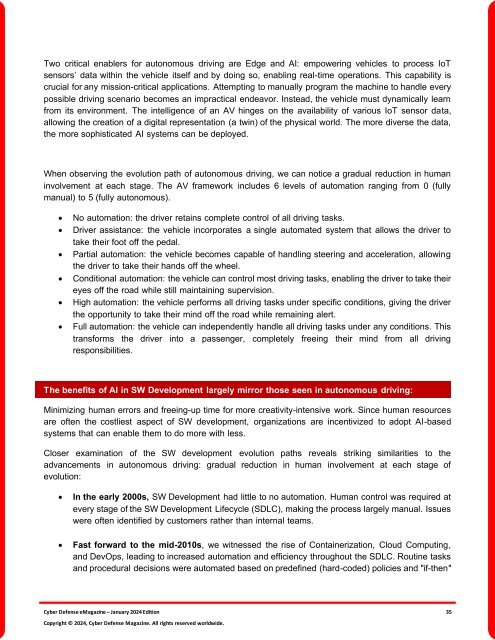The Cyber Defense eMagazine January Edition for 2024
Cyber Defense eMagazine January Edition for 2024 #CDM #CYBERDEFENSEMAG @CyberDefenseMag by @Miliefsky a world-renowned cyber security expert and the Publisher of Cyber Defense Magazine as part of the Cyber Defense Media Group as well as Yan Ross, Editor-in-Chief and many more writers, partners and supporters who make this an awesome publication! 201 page January Edition fully packed with some of our best content. Thank you all and to our readers! OSINT ROCKS! #CDM #CDMG #OSINT #CYBERSECURITY #INFOSEC #BEST #PRACTICES #TIPS #TECHNIQUES
Cyber Defense eMagazine January Edition for 2024 #CDM #CYBERDEFENSEMAG @CyberDefenseMag by @Miliefsky a world-renowned cyber security expert and the Publisher of Cyber Defense Magazine as part of the Cyber Defense Media Group as well as Yan Ross, Editor-in-Chief and many more writers, partners and supporters who make this an awesome publication! 201 page January Edition fully packed with some of our best content. Thank you all and to our readers! OSINT ROCKS! #CDM #CDMG #OSINT #CYBERSECURITY #INFOSEC #BEST #PRACTICES #TIPS #TECHNIQUES
Create successful ePaper yourself
Turn your PDF publications into a flip-book with our unique Google optimized e-Paper software.
Two critical enablers <strong>for</strong> autonomous driving are Edge and AI: empowering vehicles to process IoT<br />
sensors’ data within the vehicle itself and by doing so, enabling real-time operations. This capability is<br />
crucial <strong>for</strong> any mission-critical applications. Attempting to manually program the machine to handle every<br />
possible driving scenario becomes an impractical endeavor. Instead, the vehicle must dynamically learn<br />
from its environment. <strong>The</strong> intelligence of an AV hinges on the availability of various IoT sensor data,<br />
allowing the creation of a digital representation (a twin) of the physical world. <strong>The</strong> more diverse the data,<br />
the more sophisticated AI systems can be deployed.<br />
When observing the evolution path of autonomous driving, we can notice a gradual reduction in human<br />
involvement at each stage. <strong>The</strong> AV framework includes 6 levels of automation ranging from 0 (fully<br />
manual) to 5 (fully autonomous).<br />
• No automation: the driver retains complete control of all driving tasks.<br />
• Driver assistance: the vehicle incorporates a single automated system that allows the driver to<br />
take their foot off the pedal.<br />
• Partial automation: the vehicle becomes capable of handling steering and acceleration, allowing<br />
the driver to take their hands off the wheel.<br />
• Conditional automation: the vehicle can control most driving tasks, enabling the driver to take their<br />
eyes off the road while still maintaining supervision.<br />
• High automation: the vehicle per<strong>for</strong>ms all driving tasks under specific conditions, giving the driver<br />
the opportunity to take their mind off the road while remaining alert.<br />
• Full automation: the vehicle can independently handle all driving tasks under any conditions. This<br />
trans<strong>for</strong>ms the driver into a passenger, completely freeing their mind from all driving<br />
responsibilities.<br />
<strong>The</strong> benefits of AI in SW Development largely mirror those seen in autonomous driving:<br />
Minimizing human errors and freeing-up time <strong>for</strong> more creativity-intensive work. Since human resources<br />
are often the costliest aspect of SW development, organizations are incentivized to adopt AI-based<br />
systems that can enable them to do more with less.<br />
Closer examination of the SW development evolution paths reveals striking similarities to the<br />
advancements in autonomous driving: gradual reduction in human involvement at each stage of<br />
evolution:<br />
• In the early 2000s, SW Development had little to no automation. Human control was required at<br />
every stage of the SW Development Lifecycle (SDLC), making the process largely manual. Issues<br />
were often identified by customers rather than internal teams.<br />
• Fast <strong>for</strong>ward to the mid-2010s, we witnessed the rise of Containerization, Cloud Computing,<br />
and DevOps, leading to increased automation and efficiency throughout the SDLC. Routine tasks<br />
and procedural decisions were automated based on predefined (hard-coded) policies and "if-then"<br />
<strong>Cyber</strong> <strong>Defense</strong> <strong>eMagazine</strong> – <strong>January</strong> <strong>2024</strong> <strong>Edition</strong> 35<br />
Copyright © <strong>2024</strong>, <strong>Cyber</strong> <strong>Defense</strong> Magazine. All rights reserved worldwide.

















